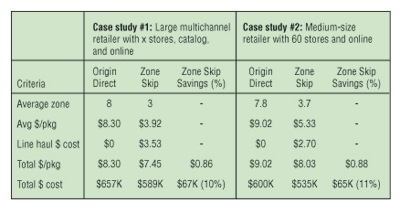Last week, in part 1 of this feature, we defined zone skipping and discussed the pros and cons. This week we’ll look at the key factors of success and how to implement a zone-skipping program that meets your distribution needs.
So you’ve decided that a zone-skipping program can most likely cut your costs or improve your delivery times? That’s great. But before you go any further, take a look at the four keys to a successful program:
1) Sufficient daily package volume. This is the most critical factor. Shippers who use zone skipping often ship multiple trailers a day and have the capability to sort and load parcels by geographic region. Shippers must have sufficient volume to build truckloads in one or two days or be willing to accept slower transit times.
2) Location, location, location. Most successful zone-skipping companies have a distribution center on either coast and have a large percentage of zones 7 and 8. The more zones you can skip the higher the savings.
3) Package weight and density. Successful zone-skip merchants tend to ship parcels weighing 5 lbs. or more. The cost spread between zones increases as weight increases up to about 55 lbs. For example, the difference in cost for a 1-lb. zone 2 parcel vs. a 1-lb. zone 8 package is 20%; for a 20-lb. parcel the cost spread is 142%. Shippers of parcels weighing less than 5 lbs. would be better served shipping direct rather than zone skipping. Product density is also important because it impacts the number of parcels that can fit in a truck. Greater density equates to higher load factors and lower line haul costs per parcel. If most of your packages are large and bulky (low density) you are less likely to cost-justify zone-skipping. 4) System support. Your shipping manifest system must have zone-skip capabilities. You must be able to rate each parcel from the carrier hub that you zone-skip to and provide the carrier with electronic package detail.
Still interested? Then it’s time to crunch the numbers to estimate potential savings. Start by following this four-step plan:
1) Take a sample of actual ground shipments for one to three months. Required fields are ship date; origin zip; destination zip; weight; zone; and, package cost. Be sure to include fuel in the package cost and apply all discounts. Sort your file by zone, and first focus in on zones 7 and 8. Do you have enough volume to these zones to build at least two trailers a week? If so, continue. If not, you are less likely to cost-justify zone skipping.
2) Look at possible drop points. In the case of an East Coast shipper zone-skipping to the West Coast, we usually start with a carrier hub in southern California and/or northern California, depending on destination volume. The higher the volume the more drop points you can justify. Calculating the average zone for each hub may help you decide.
3) Rerate all of the proposed zone-skip shipments with the new origin. Be sure to include all costs and apply all discounts. Take the total cost and divide by total cartons to arrive at zone-skip cost per package.
4) Estimate the line haul transportation cost for our zone-skip. Get several quotes for both truck and intermodal rail. Then estimate the load factor, or number of packages per trailer, based on your product weight and density. Next take the line haul cost and divide by total packages to calculate line haul cost per package. Add this cost to the zone-skip cost per package to calculate the total zone-skip cost per package. Compare this cost to the origin direct cost per package to determine if zone-skipping is right for you.
Examples of two multichannel retailers are shown below. The first is a leading multichannel merchant with 5,000 stores as well as catalog and online operations. After following the four-step methodology, it saw that total transportation cost per unit would result in a savings of 10.3%. The second case study shows a midsize North Carolina-based multichannel merchant with 60 stores and online operations. Its transportation cost savings per unit was 11%.
 Key success factors for case study #2: • Package volume–about four trailers a week to western stores. • Destination zones–68% of all shipments go to zones 7 and 8. • Package weight and density (load factor)—1,500 packages per trailer. • Systems capability–shipping and conveyor system can support zone skipping.
Key success factors for case study #2: • Package volume–about four trailers a week to western stores. • Destination zones–68% of all shipments go to zones 7 and 8. • Package weight and density (load factor)—1,500 packages per trailer. • Systems capability–shipping and conveyor system can support zone skipping.
Is zone skipping right for you? Do the math, and discuss efficiencies in the supply chain with your transportation logistics provider. Engaging it in creative ways to streamline supply chains will benefit everyone in the multichannel industry.
Jeff Kline is president of Collierville, TN-based Kline Management Consulting. Jose Li is the retail industry manager for FedEx Services.
